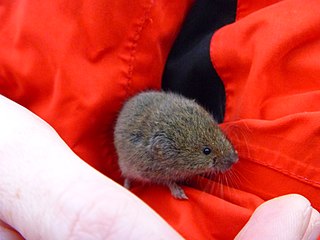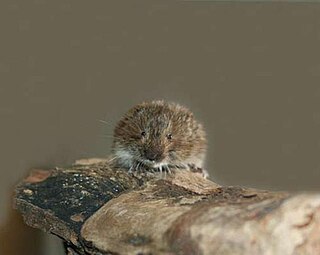
Microtus is a genus of voles found in North America, Europe and northern Asia. The genus name refers to the small ears of these animals. They are stout rodents with short ears, legs and tails. They eat green vegetation such as grasses and sedges in summer, and grains, seeds, root and bark at other times. The genus is also called "meadow voles".

The Bavarian pine vole is a vole from the Austrian, Italian, and Bavarian Alps of Europe. It lives in moist meadows at elevations of 600 to 1,000 meters.

The Tatra pine vole, also called the Tatra vole or Tatra ground vole, is a species of vole endemic to the Carpathian mountain range in Slovakia, Poland, Ukraine and Romania. Two subspecies have been recognised. M. t. tatricus occupies the western part of the range in Slovakia and Poland, and M. t. zykovi is found in Ukraine and Romania.
The Daghestan pine vole is a species of rodent in the family Cricetidae. It is found in Russia, Georgia, Armenia, and Azerbaijan.
Gerbe's vole or the Pyrenean pine vole ) is a species of rodent in the family Cricetidae found in France and Spain.
The juniper vole is a species of rodent in the family Cricetidae. It is found in Afghanistan, China, Pakistan and Tajikistan. It was formerly classified in the genus Neodon, but genetic evidence indicates that it is classified within the subgenus Blanfordimys in Microtus.
The Tien Shan vole is a species of rodent in the family Cricetidae. It is found in Afghanistan, Kazakhstan, Kyrgyzstan, Tajikistan, and Turkmenistan.

The Lusitanian pine vole is a species of rodent in the family Cricetidae. It is endemic to the northwestern half of the Iberian Peninsula where it occurs in central and northern Portugal, northwest Spain, and in the extreme south west of France.

The Mexican vole is a species of vole.
The alpine pine vole is a species of rodent in the family Cricetidae. It is found in Austria, France, Italy, Serbia, Montenegro, Bosnia and Herzegowina and Switzerland.

The East European vole is a species of vole (rodent) in the family Cricetidae.

Savi's pine vole is a species of rodent in the family Cricetidae. It is found in France and Italy.
Schelkovnikov's pine vole is a species of rodent in the family Cricetidae. It is found in Azerbaijan and Iran. It has recently been considered the sole species in the subgenus Hyrcanicola.
Thomas's pine vole is a species of rodent in the family Cricetidae. It is found in Bosnia and Herzegovina, Greece, Montenegro, North Macedonia, Serbia, and possibly Albania.
The Transcaspian vole is a species of rodent in the family Cricetidae. It is found in Afghanistan, Iran, and Turkmenistan.
The Qazvin vole is a species of rodent in the family Cricetidae. It is found in Iran and is normally given as either part of the Microtus or Sumeriomys subgenus. It is a close relative of M. guentheri distinguished by different pelage coloration and a more complex occlusal pattern.
Schidlovsky's vole is a species of rodent in the family Cricetidae. It is normally found in northwestern Armenia, and was long considered a subspecies of the social vole until relisted as a species by Golenishchev in 2002.
Major's pine vole is a species of rodent in the family Cricetidae found in Caucasus region and its vicinities.

Terricola is a subgenus of voles in the genus Microtus. The authority for this taxon is Fatio in 1867. Earlier use of the name by John Fleming has no formal taxonomic standing. Species in this subgenus are:






